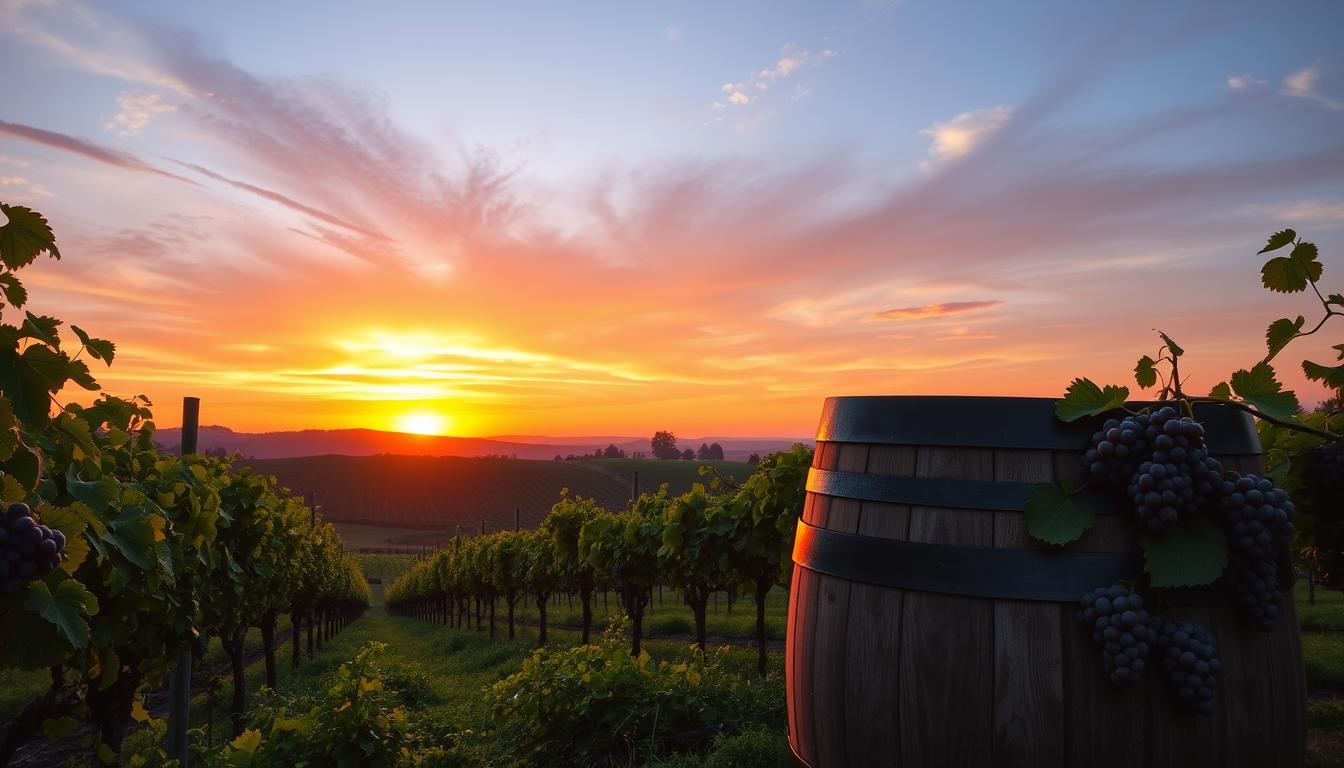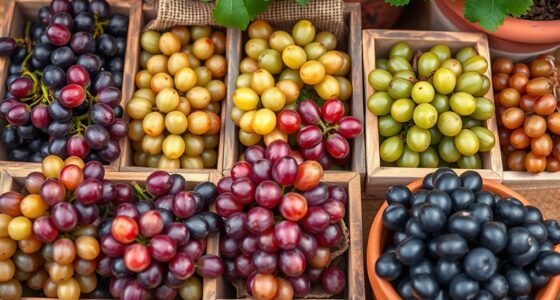For many of us, pouring a glass of wine doesn’t just mark the end of a long day; it provides a moment of connection. Whether it’s a special celebration or an intimate dinner with friends, each sip tells a story. It’s fascinating to think about the vast world of popular wine varietals waiting to be explored. Did you know that wine is made with over a thousand types of grapes? Among these, just eight represent six of the nine wine styles, making them immensely popular and defining the taste of many memorable experiences.
This article will take you through the characteristics that elevate these top wine grape varieties, such as Cabernet Sauvignon, which is celebrated as the most popular wine variety worldwide, and Chardonnay, a staple that has found its way into countless wine lovers’ hearts. You’ll discover not only the best red wine varietals, but also the common white wine varietals that make any occasion a little brighter. As we journey through the vineyards and cellars of the world, keep in mind how these wines complement our lives and palates; let’s dive in.
Key Takeaways
- Wine is crafted from over a thousand grape varieties, with eight common types leading the way.
- Cabernet Sauvignon is recognized as the most popular red wine globally.
- Chardonnay is a widely planted white wine, available in both oak-aged and unoaked variations.
- Popular blending varieties include Syrah, Grenache, and Mourvèdre, creating rich, full-bodied wines.
- The popular white varietal Sauvignon Blanc offers bright, tart flavors, enhancing many meals.
- Wine can enhance special moments, creating lasting memories and connection with others.
Introduction to Wine Varietals
Wine varietals arise from distinct wine grape types, each offering unique profiles in terms of flavor, aroma, and texture. With over 10,000 grape varieties cultivated around the world, wine enthusiasts have a vast selection to explore. Among these, popular wine classifications like Cabernet Sauvignon, Merlot, and Chardonnay have established their stronghold in both market and consumer preference.
In the United States, regulations stipulate that a wine must consist of at least 75% of a single grape to qualify as a varietal. This allows consumers to easily identify the primary grape type that shapes the wine’s character. Similarly, in Canada, the requirement is slightly higher, with an 85% threshold for the varietal label. Understanding these wine grape types not only aids in selection but also enhances appreciation for the complexities each varietal brings.
As you delve deeper into the world of wine, you’ll discover that red wines typically exhibit higher tannin levels due to their extended skin contact during fermentation. In contrast, white wines can showcase an extensive range of flavors, influenced by the winemaker’s choices and the terroir. For instance, Barbera from Italy’s Piedmont region is renowned for its low tannins and vibrant acidity, while Carménère from Chile boasts unique green bell pepper notes.
Exploring these popular wine classifications paves the way for a richer wine journey. Let the diversity within wine varietals invite you to expand your palate and enhance your dining experiences.
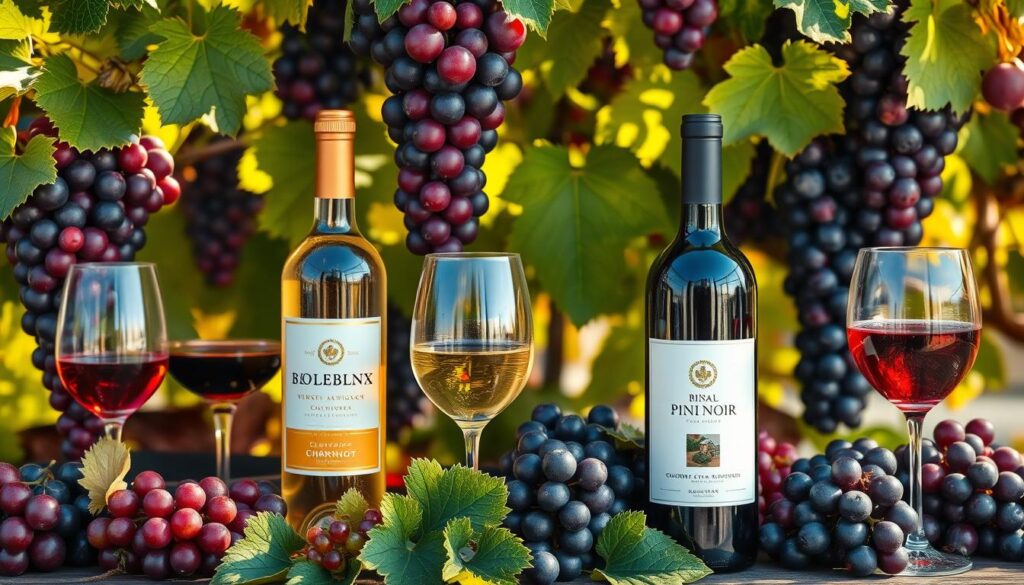
What Makes a Wine Varietal Popular?
The popularity factors behind certain wine varietals stem from a combination of characteristics that appeal to consumers. Flavor profiles play a significant role in drawing consumers in, with wines that have well-balanced tastes often being favored. Varietals like Chardonnay and Cabernet Sauvignon stand out due to their consistent quality and versatility in food pairing.
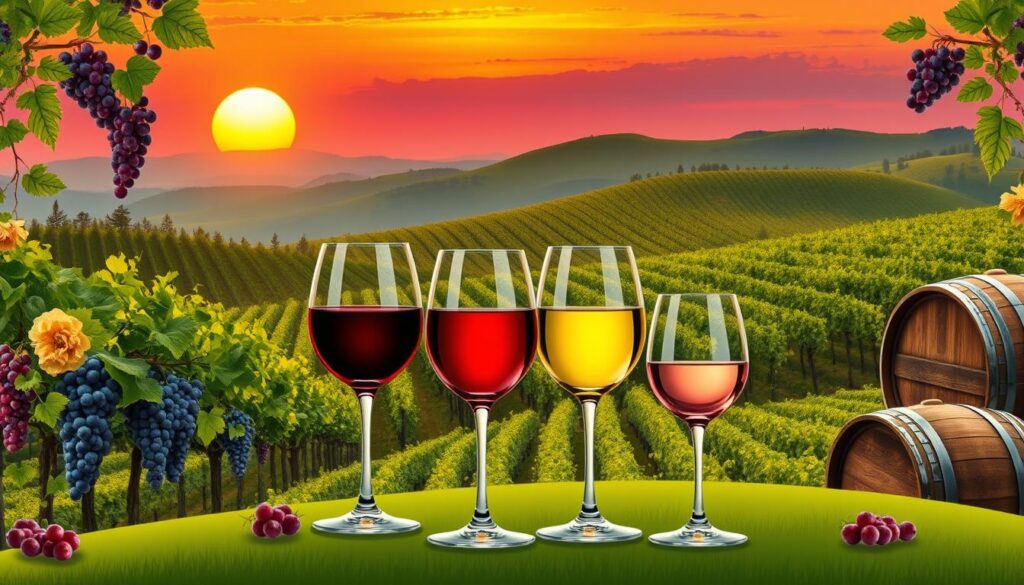
The impact of market trends cannot be overlooked when considering wine varietal appeal. Cultural influences, such as films or popular dining experiences, subtly shape consumer preferences. For example, as consumers seek unique, high-quality wines, varietals like Sauvignon Blanc from New Zealand’s Marlborough region have surged in popularity for their aromatic intensity.
Understanding consumer preferences is essential. Over 10,000 grape varieties exist, yet only a select few maintain consistent popularity. Regions such as Bordeaux for Cabernet Sauvignon and Burgundy for Pinot Noir demonstrate the importance of geographical identity in defining these varietals. In contrast, New World wines are increasingly adopting systems that highlight grape varieties, further influencing consumer choices.
| Varietal | Notable Features | Primary Regions |
|---|---|---|
| Chardonnay | Noble white varietal, rich and complex | Globally planted |
| Sauvignon Blanc | Intensely aromatic, gaining fame | New Zealand, Loire Valley |
| Cabernet Sauvignon | King of red wines, high depth and longevity | Bordeaux, California |
| Pinot Noir | Noble red variety, known for exclusivity | Burgundy, Oregon |
| Merlot | Most widely grown red varietal, versatile | California, Bordeaux |
Ultimately, the interplay of these elements shapes the enduring appeal of specific varietals, guiding consumers in their wine selection journey.
Top Wine Grape Varieties Worldwide
In the world of wine, certain grape varieties stand out, dominating both production and popularity. These wine grape varieties not only foster a plethora of profiles and tastes but also reveal rich histories rooted in their grape cultivation regions.
Cultivated Regions
Major grape cultivation regions contribute significantly to global wine production. Notably:
- Cabernet Sauvignon reigns supreme, with around 840,000 acres devoted to it worldwide, establishing it as the most widely grown grape variety.
- Merlot follows, with 657,300 acres, showcasing a history that includes a decline from its earlier prominence.
- Tempranillo ranks third, primarily rooted in Spain, covering approximately 570,800 acres.
- The fifth most planted is Chardonnay, with around 518,900 acres, while Sauvignon Blanc takes eighth place at 299,000 acres.
The Dominance of International Varieties
International wine grape varieties play an essential role in shaping the wine landscape. Regions like France, the U.S., Chile, and Australia emphasize particular varieties based on consumer preferences and local traditions. These top wine regions each have their own signature varietals that have become world-renowned for their quality and unique flavor profiles. For example, France is known for its Cabernet Sauvignon and Chardonnay, while Chile is famous for its Carménère and Sauvignon Blanc. These international grape varieties have influenced winemaking practices around the world, leading to a diverse and dynamic range of wines for consumers to enjoy.
For instance, as interest in Syrah grows, especially in Australia, Grenache Noir has experienced a noticeable decline from its previously high ranks. Notably:
- New World countries advocate a consumer-focused approach, emphasizing grape variety in marketing.
- With 10,000 grape varieties in existence, merely 33 varieties constitute half of the vineyard space worldwide.
- Regional specifics, such as South Africa’s increase in white wine production, help alleviate global shortages.
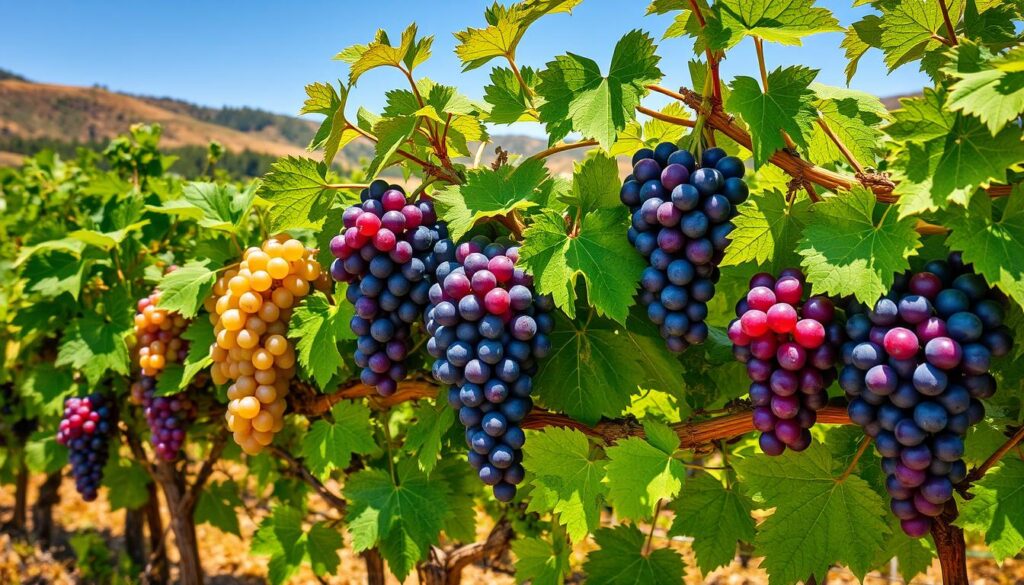
Best Red Wine Varietals
Exploring the best red wine varietals can enrich your wine experience. Each varietal brings distinct characteristics and flavor profiles that cater to diverse palates. Here’s a closer look at three popular red wines that consistently stand out.
Cabernet Sauvignon
Recognized as one of the most widely planted grape varieties globally, Cabernet Sauvignon is known for its bold flavors. Characterized by notes of black cherry, blackberry, and hints of spices, this varietal possesses a full body that offers a rich tasting experience. The Cabernet Sauvignon characteristics include its high tannin content, making it an excellent choice for aging. This grape serves as the backbone for many wines produced in regions like Bordeaux and Napa Valley and pairs beautifully with hearty dishes such as lamb and beef.
Merlot
Merlot comes next, showcasing a softer taste profile that appeals to many wine drinkers. This varietal is celebrated for its stylistic variety, ranging from fruit-forward to more structured options. Although its popularity has fluctuated over the years, Merlot remains a key component in classic Bordeaux blends. It’s an approachable wine that pairs well with a variety of foods, making it a favorite among those discovering the world of red wines.
Tempranillo
Tempranillo is widely regarded as Spain’s flagship grape. It features an earthy quality enriched by vibrant fruit flavors, making it distinct among the best red wine varietals. Typically used in Spanish blends, particularly from regions like Rioja, Tempranillo reflects the terroir where it’s grown. The depth of flavor in Tempranillo offers excellent pairing suggestions with dishes like grilled meats and savory stews.

| Red Wine Varietal | Tasting Notes | Food Pairings | Characteristics |
|---|---|---|---|
| Cabernet Sauvignon | Bold, black cherry, spice | Lamb, beef, rich sauces | Full-bodied, high tannins |
| Merlot | Soft, plummy, versatile | Pasta, chicken, pizza | Medium-bodied, approachable |
| Tempranillo | Earthy, fruit-forward | Grilled meats, stews | Medium-bodied, blends well |
Common White Wine Varietals
When it comes to popular white wine types, two varietals stand out among the rest: Chardonnay and Sauvignon Blanc. Each offers a unique flavor profile and versatility, appealing to a wide range of wine lovers. Understanding these common white wine varietals can greatly enhance your wine experience and food pairings.
Chardonnay
The Chardonnay description reflects a grape renowned for its incredible diversity. Originating from France, Chardonnay can manifest in various styles, from crisp apple flavors in cooler climates to tropical fruit aromas in warmer regions. This versatility makes it an ideal accompaniment for various dishes, ranging from seafood to creamy pasta. Chardonnay’s ability to age beautifully, particularly when matured in oak, adds further appeal.
Sauvignon Blanc
Sauvignon Blanc is another leading player in the realm of popular white wine types. Best known for its crisp acidity and refreshing profiles, this grape often delights with flavors of citrus and green herbs. Growing predominantly in warmer climates, Sauvignon Blanc wines can exhibit lush fruitiness while still maintaining their signature crispness. Pairing well with salads, seafood, and light poultry dishes, Sauvignon Blanc provides the perfect balance on your palate.
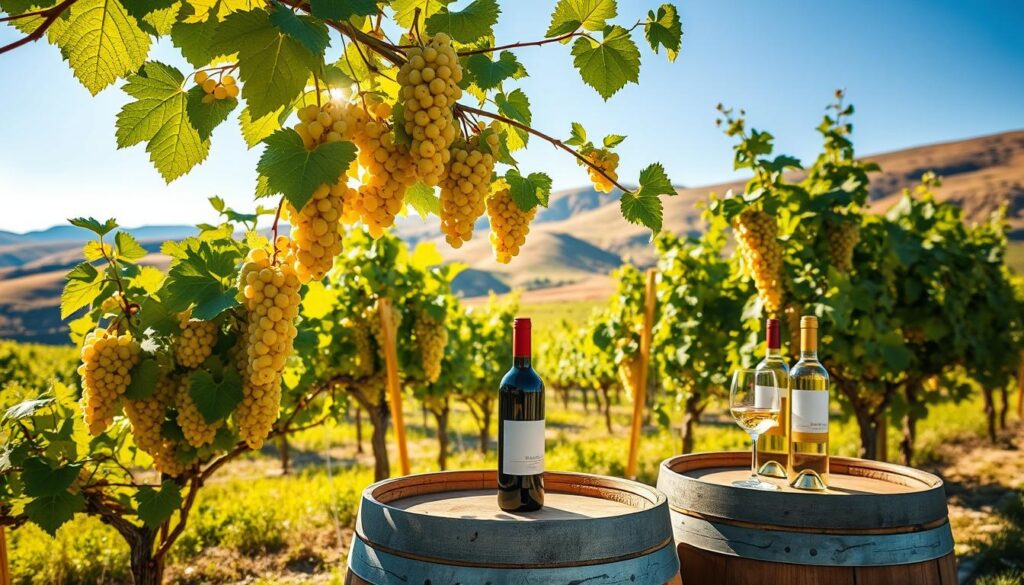
| Varietal | Flavor Profile | Ideal Pairings |
|---|---|---|
| Chardonnay | Crisp apple, tropical fruit | Seafood, creamy pasta, roast chicken |
| Sauvignon Blanc | Citrus, grassy, herbal | Salads, seafood, light poultry |
Exploring Famous Grape Varietals
Famous grape varietals have shaped the wine landscape with their distinctive characteristics and flavors. Among these, Syrah stands out for its rich fruitiness coupled with spicy notes, making it a favorite in well-known wines from regions like Australia and the Rhône Valley. The versatility of this varietal plays a significant role in its appeal.
Zinfandel, often celebrated for its fruit-forward profile, showcases spicy undertones that stem from a deep-rooted history in American winemaking. This grape thrives almost exclusively in California, where it produces vibrant wines bursting with raspberry and blackberry aromas, further solidifying its position among iconic varietals.
Pinot Noir offers a different experience, known for its elegance and layered complexity. This grape varietal delivers flavors of cherry and raspberry, allowing it to pair seamlessly with a variety of cuisines, enhancing its popularity among wine enthusiasts. The expression of terroir in Pinot Noir adds to its allure, inviting exploration from vineyards in Burgundy, France, to California and New Zealand.
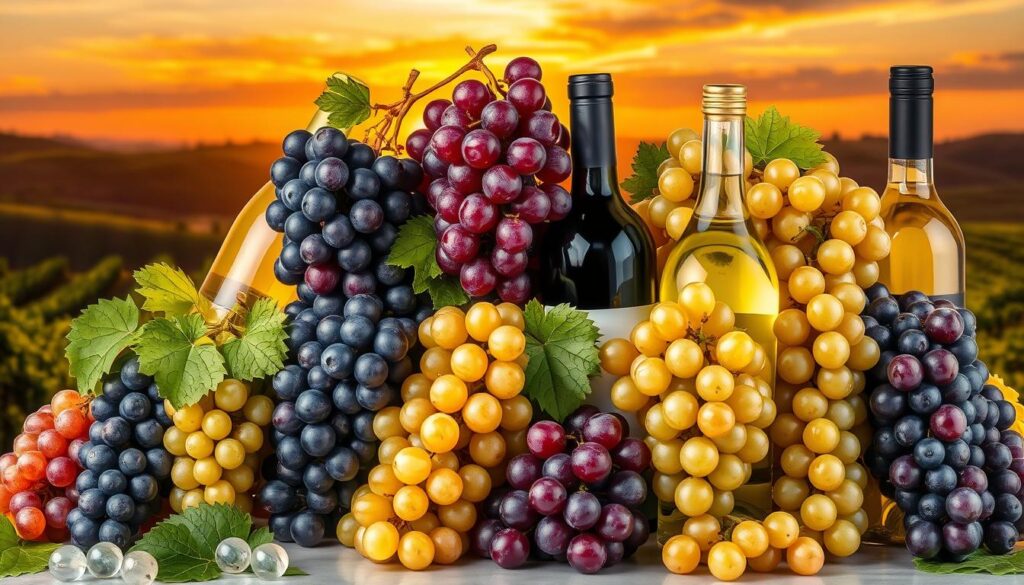
| Grape Varietal | Key Flavors | Regions |
|---|---|---|
| Syrah | Rich fruit, spice | Australia, Rhône Valley |
| Zinfandel | Raspberry, blackberry, spice | California |
| Pinot Noir | Cherry, raspberry | Burgundy, California, New Zealand |
| Cabernet Sauvignon | Blackcurrant, plum, tobacco | Bordeaux, California, Australia |
| Merlot | Plum, cherry, chocolate | Bordeaux, California, Chile |
Each of these famous grape varietals not only represents its unique flavor profile but also reflects a rich tapestry of history and geography. Whether you lean towards the boldness of Syrah or the finesse of Pinot Noir, there’s a world of well-known wines waiting to be discovered, enhancing your wine journey.
Popular Wine Blends
Blending wine is an artistry that brings together various varietals to create complexity and depth in flavor. Popular wine blends capture the essence of this craft, appealing to both novice drinkers and seasoned enthusiasts. A prime example is the Bordeaux blend, which typically includes Merlot, Cabernet Sauvignon, and Cabernet Franc. These red wine mixtures perfectly balance richness and smoothness, appealing to many palates.
Rhône blends showcase a different style, combining Syrah, Grenache, and Mourvèdre. This mixture offers a diverse spectrum of flavors, making it a versatile choice for various occasions. Another notable mention is Chianti, predominantly Sangiovese, which can also incorporate up to 15% Cabernet Sauvignon and Cabernet Franc, enhancing its character with fruity and floral notes.
On the white wine side, Bordeaux blends often consist of Sémillon and Sauvignon Blanc, sometimes augmented with Muscadelle. These white wine assemblages provide crisp and refreshing profiles ideal for pairing with lighter dishes.
Understanding the art of blending enriches your wine experience. Below is a table showcasing some popular blends, their key grape varieties, and interesting aspects:
| Blend Name | Main Grape Varieties | Flavor Profile |
|---|---|---|
| Bordeaux Red | Merlot, Cabernet Sauvignon, Cabernet Franc | Rich, velvety, and complex |
| Châteauneuf du Pape | Grenache, Syrah, Mourvèdre | Fruit-forward with spicy undertones |
| Chianti | Sangiovese, Cabernet Sauvignon, Cabernet Franc | Medium-bodied with cherry and herbal notes |
| Super Tuscan | Sangiovese, Merlot, Cabernet Sauvignon | Bold, layered, and robust |
| Soave | Garganega, Trebbiano, Chardonnay | Crisp with floral and citrus hints |
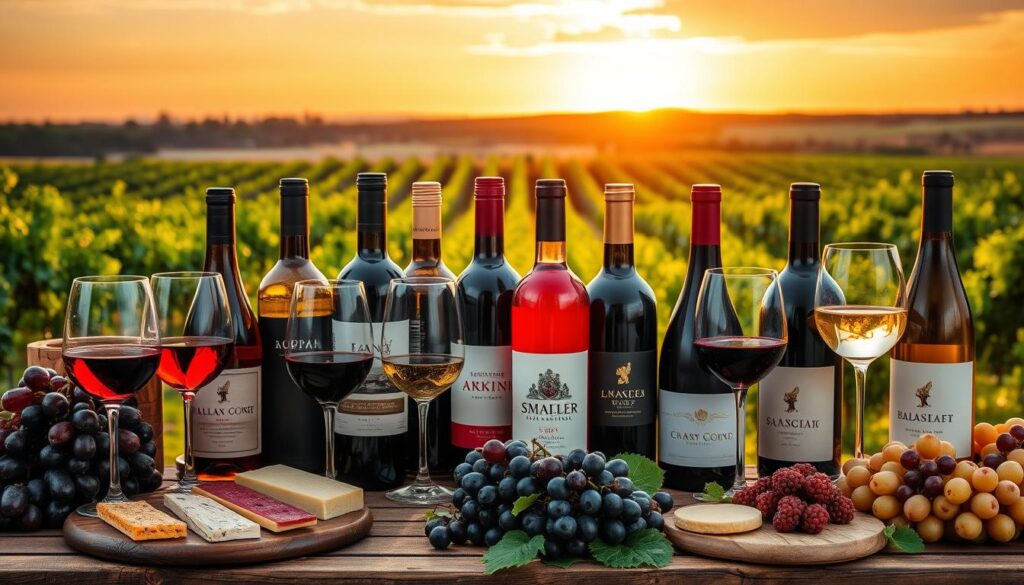
Popular Wine Varietals and Their Food Pairings
Understanding food pairings enhances your overall wine experience. Each wine varietal offers unique flavors that complement different dishes. Below are practical pairing suggestions for both red and white wine, allowing you to elevate your dining occasions with delightful wine pairings.
Red Wine Pairing Suggestions
Red wines bring bold flavors and can enhance a variety of dishes. Consider the following *pairing suggestions*:
- Cabernet Sauvignon: This wine pairs beautifully with meat and game dishes, making it an ideal match for steaks, beef, and rich cheeses. It complements the robust flavors of a hearty meal.
- Merlot: Known for its elegance, Merlot suits white and red meat dishes, mushrooms, and semi-aged cheeses. It pairs wonderfully with lamb or pasta for a rich culinary experience.
- Pinot Noir: This versatile wine complements salmon, roast chicken, and grilled meats, making it a fantastic option for lighter red and white wine food matches.
White Wine Pairing Suggestions
White wines offer refreshing flavors that pair well with a variety of light dishes. Here are some excellent *pairing suggestions*:
- Chardonnay: Known for its creamy texture and hints of lemon and vanilla, Chardonnay pairs well with seafood, chicken, and vegetarian dishes, as well as soft cheeses.
- Sauvignon Blanc: This lively wine is perfect for fish dishes, risottos, and vegetable-based pasta. Its herbaceous notes enhance the freshness of dishes such as asparagus and goat cheese.

| Wine Varietal | Food Pairings |
|---|---|
| Cabernet Sauvignon | Steak, Beef, Game Dishes, Rich Cheeses |
| Merlot | White Meat, Red Meat, Mushrooms, Pasta |
| Pinot Noir | Salmon, Roast Chicken, Grilled Meats |
| Chardonnay | Seafood, Chicken, Vegetarian Dishes, Soft Cheeses |
| Sauvignon Blanc | Fish Dishes, Risottos, Vegetables, Goat Cheeses |
These *red and white wine food matches* will not only enhance your dining experience but also encourage a deeper appreciation for each varietal’s characteristics. Enjoy exploring these delightful combinations!
Conclusion
As we wrap up our wine varietals summary, it’s clear that the world of wine offers a diverse range of flavors, aromas, and experiences. Varietals like Cabernet Sauvignon and Chardonnay stand out not just for their popularity but for their unique characteristics that have captivated wine lovers for centuries. The lasting allure of these wines is a testament to the art of winemaking and the appreciation of their origins and terroirs.
Your journey into wine appreciation becomes more fulfilling when you explore various styles such as robust Malbecs or elegant Pinot Noirs, each with their distinct profiles and potential for delightful food pairings. By broadening your palate and embracing lesser-known varietals like Gewürztraminer or Grenache, you can enhance your dining experiences and deepen your understanding of what makes each wine special.
In the end, the final thoughts on popular varietals suggest that this ever-evolving landscape of wine continues to intrigue both enthusiasts and newcomers alike. Every bottle has a story, and with every sip, you are participating in a centuries-old tradition that grows richer with time. So, why not raise a glass, explore beyond the familiar, and discover the endless possibilities that await you in the world of wine?

